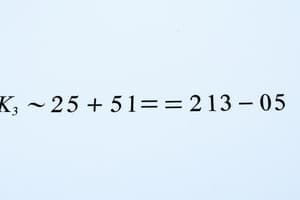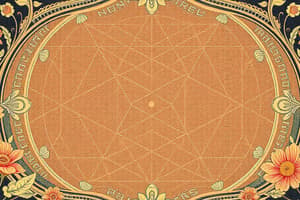Podcast
Questions and Answers
What is the definition of accuracy?
What is the definition of accuracy?
Closeness of measured value to correct value.
What is the definition of precision?
What is the definition of precision?
Closeness of measured value to other measured values.
What is the conversion factor from kilometers to feet?
What is the conversion factor from kilometers to feet?
1 km = 3281 ft.
Why are leading zeros to the left of non-zero digits not significant?
Why are leading zeros to the left of non-zero digits not significant?
Why is it important for measurements in an experiment to be both accurate and precise?
Why is it important for measurements in an experiment to be both accurate and precise?
What is the mass of the cone using the triple beam balance?
What is the mass of the cone using the triple beam balance?
Which measurement would not be possible to obtain from the triple beam balance?
Which measurement would not be possible to obtain from the triple beam balance?
What is the mass of the light bulb?
What is the mass of the light bulb?
What is the mass of the light bulb and paperclips together?
What is the mass of the light bulb and paperclips together?
A number should be rounded up if _______.
A number should be rounded up if _______.
How many significant figures are in the measurement 0.020 km?
How many significant figures are in the measurement 0.020 km?
Which of the following is not one of the three principles from which the metric system is based?
Which of the following is not one of the three principles from which the metric system is based?
When converting from kilometers to meters, the decimal is moved _______.
When converting from kilometers to meters, the decimal is moved _______.
What is 0.25 kilometers expressed in centimeters?
What is 0.25 kilometers expressed in centimeters?
Explain why significant figures represent the precision of a measurement and not its accuracy.
Explain why significant figures represent the precision of a measurement and not its accuracy.
What is the difference between accuracy and precision in scientific measurement?
What is the difference between accuracy and precision in scientific measurement?
Explain why scientists use the metric system for scientific measurements.
Explain why scientists use the metric system for scientific measurements.
What are the basic prefixes used in the metric system and how do they relate to the size of the base unit?
What are the basic prefixes used in the metric system and how do they relate to the size of the base unit?
Flashcards are hidden until you start studying
Study Notes
Scientific Measurement Concepts
- Accuracy refers to how close a measured value is to the correct value, while precision measures the closeness of measured values to each other.
- Leading zeros positioned to the left of non-zero digits are not considered significant, acting only as placeholders.
Measurement and Unit Conversion
- Conversion from kilometers to feet involves using a factor of 1 km = 3281 ft.
- When converting kilometers to meters, move the decimal three places to the right, with 0.25 kilometers equating to 25000 centimeters.
Significance of Measurements
- Accurate measurements ensure meaningful results in experiments; precision alone does not guarantee correctness if calibration is off.
- Significant figures indicate the precision of a measurement, where a greater number leads to reduced error margins.
Metric System Fundamentals
- The metric system (SI - International System of Units) allows for uniform measurements internationally, aiding clear communication between scientists.
- Basic prefixes in the metric system: kilo (1000), hecto (100), deka (10), milli (1/1000), centi (1/100), deci (1/10).
Practical Measurement Scenarios
- Mass of a cone obtained from a triple beam balance is recorded as 543.0 g, while the combined mass of a light bulb and paperclips is 251.0 g.
- When rounding a number, if the digit following it is between 5 and 9, the preceding number should be rounded up.
Understanding Accuracy vs Precision
- Accuracy reflects the closeness of a measurement to the actual value, while precision pertains to the repeatability of measurements taken under unchanged conditions.
- A measurement can be precise without being accurate; for example, 1.5422 m vs. 1.2 m, where the first may be more precise, but the latter could be more accurate depending on the actual value.
Miscellaneous
- Not all principles of the metric system are universally applicable; for instance, metric measurements can be converted to other measurement forms.
Studying That Suits You
Use AI to generate personalized quizzes and flashcards to suit your learning preferences.




